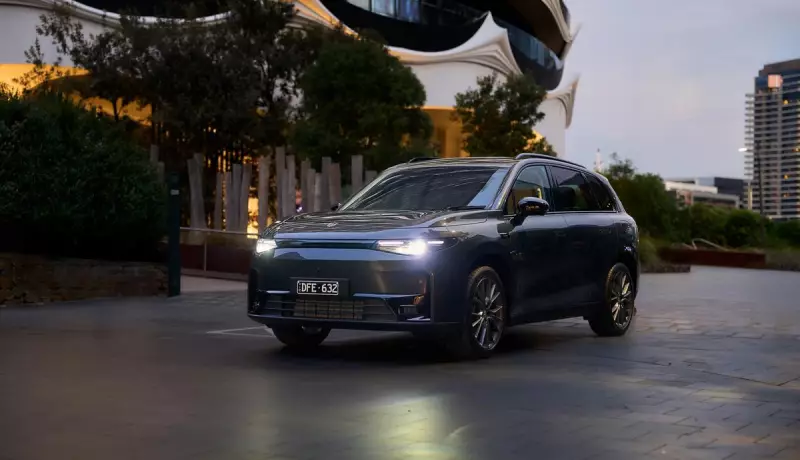
The Leapmotor C10 has arrived on Australian shores, bringing Chinese electric vehicle innovation with a European twist thanks to its Stellantis partnership. This medium SUV promises cutting-edge technology and a comfortable ride, but our testing reveals some technological quirks that might test drivers' patience.
First Impressions and Unconventional Entry
Your first encounter with the Leapmotor C10 might leave you scratching your head. Unlike traditional vehicles, the C10 comes with an NFC card instead of a physical key, similar to Tesla's approach. However, finding where to swipe the card becomes an unexpected puzzle.
Nothing happens when you swipe the card on the door pillar or handle. The solution lies in the side mirror, which features a tiny, body-coloured wireless icon. This unusual placement makes for an entertaining party trick, challenging friends to figure it out within five seconds. For daily convenience, downloading the companion app allows smartphone access.
Technical Specifications and Australian Pricing
The C10 landed in Australia during late 2024, with the hybrid C10 REEV (Range Extended Electric Vehicle) following in early 2025. Our test vehicle was the 2024 top-spec Design trim, priced from $49,888 RRP before on-road costs. With premium Jade Green paint adding $990, the total reached $50,878. The entry-level C10 Style trim starts from $45,888 RRP.
Under the sleek exterior lies a rear-wheel drive setup with a single rear-mounted motor producing 160kW of power and 320Nm of torque. The 69.9kWh lithium ferro-phosphate battery delivers a WLTP-rated range of 420km and energy consumption of 19.8kWh/100km combined. Acceleration from 0-100km/h takes 7.5 seconds, with a top speed of 170km/h.
Interior Comfort and Technology Features
Step inside, and you're greeted by a minimalist cabin dominated by two screens: a 14.6-inch central display and 10.25-inch instrument cluster. The C10 features a welcome addition often overlooked by competitors - a glass roof with a sunshade, preventing cabin overheating during Australian summers.
Upholstery comes in Criollo Brown silicone leather, a synthetic material that mimics genuine leather while offering enhanced durability and easier cleaning. The heated and ventilated front seats provide excellent comfort, and there's ample space throughout the cabin.
All vehicle controls, including temperature, air flow, and even air vent direction, operate through the central touchscreen. The C10 includes a wireless charging pad, 12-speaker sound system, multi-colour ambient lighting, and built-in 4G connectivity with essential apps like Spotify, TikTok, and Zoom.
However, the notable absence of Apple CarPlay and Android Auto might disappoint some users, though an over-the-air update recently introduced QDLink for Android phone projection.
Driving Experience and Software Quirks
On the road, the C10 demonstrates its Stellantis connection with what enthusiasts describe as a Maserati-tuned ride quality. The rear-wheel drive configuration provides good stability, responsive steering, and minimal wind noise - an impressive achievement for any electric vehicle.
During our testing week, energy consumption ranged between 13.4-14.5kWh/100km with i-Pedal engaged, significantly better than the official 19.8kWh/100km figure. The i-Pedal system enables one-pedal driving but can only be activated via the touchscreen while in Park mode, limiting flexibility during driving.
The most significant issue emerged from the constant barrage of pings, beeps, and warnings. The advanced driver assistance systems (ADAS) proved overly aggressive, creating an endless loop of alerts that could distract rather than assist drivers.
Fortunately, Leapmotor announced an over-the-air software update during our testing period to address these calibration issues specifically for European and Australian markets. The update also adds Radioline global streaming and dashcam recording capability using the surround-view cameras.
Charging, Safety and Ownership Details
Charging capabilities show room for improvement in today's competitive EV market. The C10 takes approximately 6.1 hours for 30-80% charge using 6.6kW AC, while DC fast charging achieves the same in 30 minutes at 84kW - slower than many contemporary electric vehicles.
Safety credentials are strong, with the C10 earning a five-star ANCAP safety rating based on 2024 testing. It scored 89% for adult-occupant protection, 87% for child-occupant protection, 77% for vulnerable road-user protection, and 77% for safety assist.
Active safety features are comprehensive, including a 360-degree camera, lane-centring control, adaptive cruise control, front and rear collision warning, lane-keep assist, emergency lane keeping, and multi-collision braking.
The 2024 model comes with a seven-year/160,000km factory warranty, eight-year/160,000km high-voltage battery warranty, and five years of roadside assistance. Service intervals occur every 12 months or 20,000km. Potential buyers should note that warranty and service details have changed for 2025 models.
Servicing occurs through the Stellantis dealer network, including Barbagallo Leapmotor in Osborne Park for Western Australian customers.
Brand Background and Global Expansion
Leapmotor represents one of China's emerging EV startups, founded in 2015 as Lingpao Automobile Co by electrical engineer Zhu Juangming. The company focuses on intelligent electric vehicle design and recently formed Leapmotor International - a 51/49 Stellantis-led joint venture based in Amsterdam - to expand globally.
Stellantis, parent company to brands including Maserati, Jeep, Fiat, and Alfa Romeo, holds a 51% controlling share in Leapmotor International. This partnership provides access to established distribution channels, making the C10 Leapmotor's first truly global product.
The C10 follows Leapmotor's initial models - the discontinued S01 two-door coupe and T03 five-door commuter car - leveraging Stellantis's expertise to compete in international markets.
Despite its technological teething problems, the Leapmotor C10 presents an intriguing option in Australia's growing electric SUV segment, combining competitive pricing with premium features and the backing of a major automotive group.





